What is Frequency Shift Keying (FSK)?
Frequency Shift Keying (FSK) is a digital modulation technique used to transmit data by changing the frequency of a carrier wave. In FSK, the carrier wave frequency is shifted between two or more discrete values to represent binary data.
How does FSK work?
1. Binary Data: Digital data is converted into binary format (0s and 1s).
2. Carrier Wave: A carrier wave is generated at a specific frequency.
3. Frequency Shifting: The frequency of the carrier wave is shifted between two or more discrete values to represent the binary data.
4. Transmission: The modulated carrier wave is transmitted over a communication channel.
5. Demodulation: The received signal is demodulated to extract the original binary data.
In frequency shift Keying, the frequency of carrier signal changes concerning the binary data b(t).
Table of Contents
Binary frequency shift keying(BFSK):
In binary frequency shift keying, s(K)=Accos(2πfc+b(t) delta(f))
fi=fc+b(t) delta(f)
b(t)=1 f1=fc+ delta(f)
b(t)=0. f2=fc– f
for bipolar representation, logic 1 is +1V
logic 0=-1V
s(t)=Ac1cos2 πfc1t—-f1
s(t)=Ac1cos2 πfc2t—–f2
BFSK transmitter:
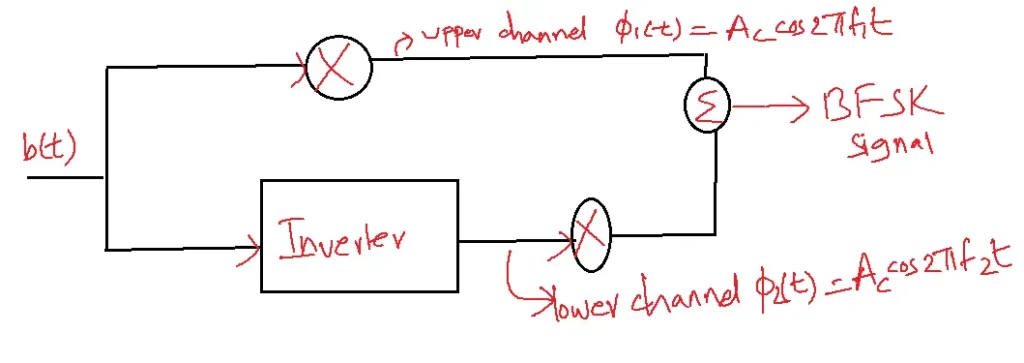
s(t)=b(t) Ac1cos2 πfc1t+ Ac1cos2 πfc2t
s(t)= Accos2 πf1 if binary data is 1
s(t)= Accos2 πf2t if binary data is 0.
VCO as BFSK(transmitter):
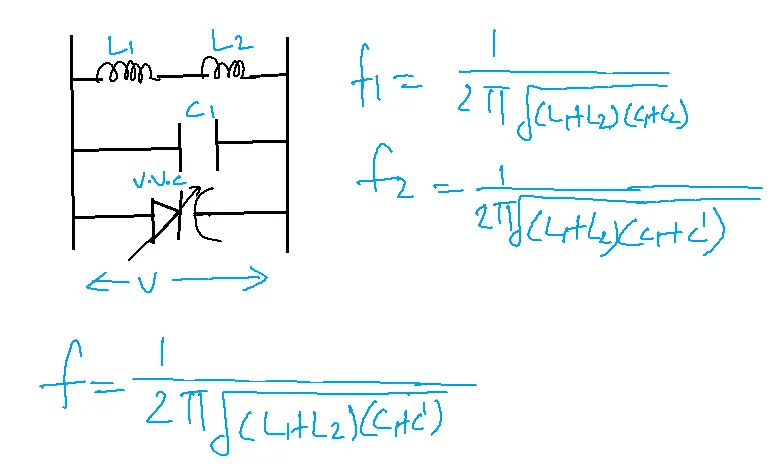
If b(t)=1, letC’=C2
Power Spectral Density and Bandwidth of BFSK:
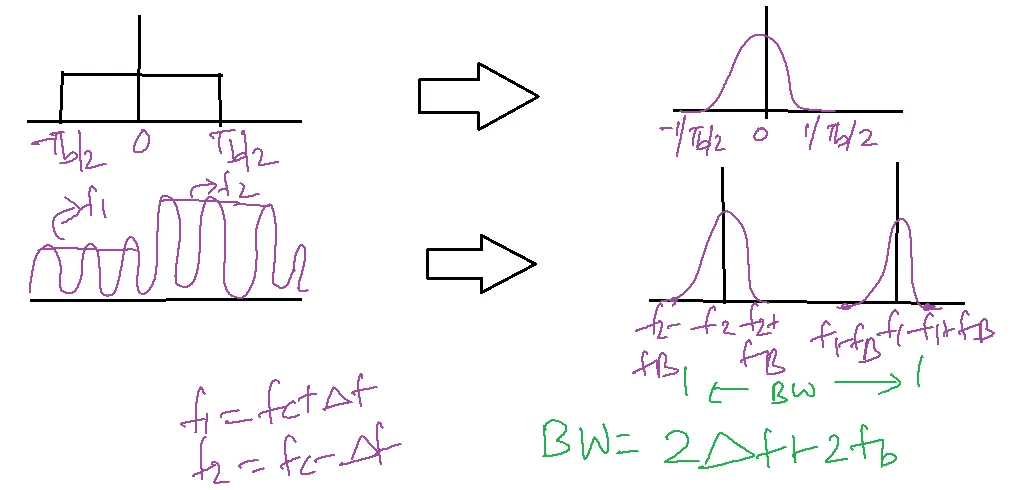
BW=(f1+fb)-(f2-fb)
BW=(f1-f2)+2fb
BW=4fb
Frequency shift keying Demodulation:
There are two types of detectors:
1. Coherent FSK detector
2. Envelope detector
Coherent FSK Detector:
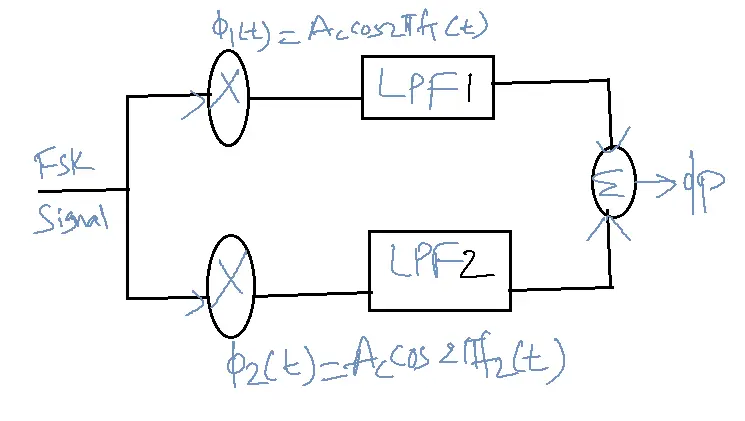
s1(t)= Accos2 πf1(t)
s2(t)= Accos2 πf2(t)
s(t)= S1(t)+ S2(t)
If s(t)=s1(t)
Output of LPF-2 is 0
The final output is a Square of (Ac)/2
If s(t)=s2(t)
The output of LPF-1 is Square of (Ac)/2
Output of LPF-2 is 0
Case-2:
If s(t)=s2(t)= Accos2 πf2(t)
LPF 1 output is zero.
LPF 2 output is Ac2/2
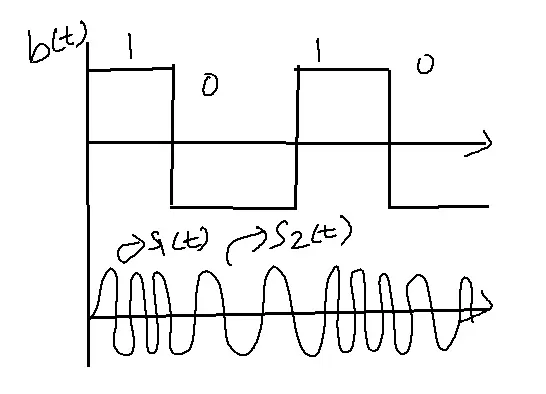
Analog Detector of FSK:
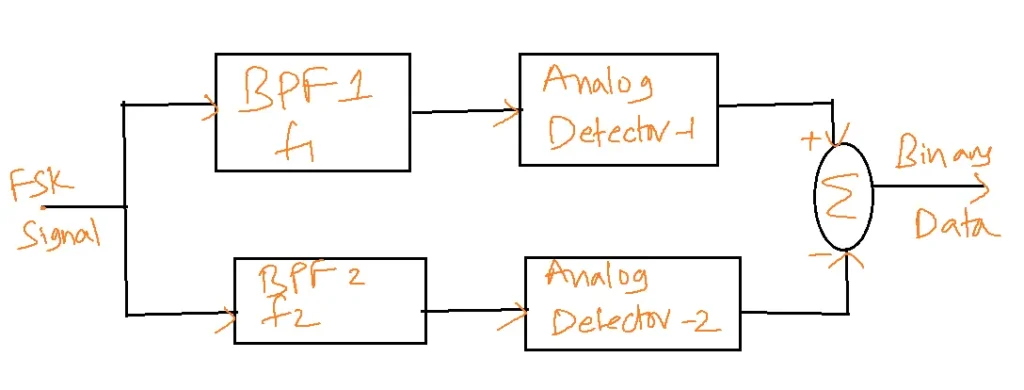
Case-1: Let s(t)=s1(t)= Accos2 πf1t
Output is Ac
Case-2: Let s(t)=s2(t)= Accos2 πf2t
Output is -Ac
s(t)=s1(t)
output of BPF-1 is Accos2 πf1t
the output of Analog Detector 1 is Ac
s(t)=s2(t)
output of BPF-2 is Accos2 πf2t
the output of Analog Detector 2 is -Ac
Signal Space Representation of Frequency Shift Keying
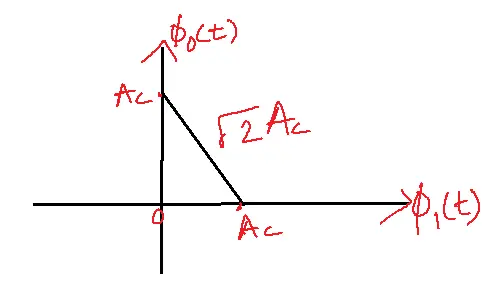
Advantages of FSK
1. Resistant to Noise: FSK is less susceptible to noise and interference compared to other modulation techniques.
2. Simple Implementation: FSK is relatively easy to implement and understand.
3. Low Power Consumption: FSK requires less power to transmit than other modulation techniques.
4. High Data Rate: FSK can achieve high data rates compared to other modulation techniques.
Disadvantages of FSK
1. Bandwidth Requirements: FSK requires more bandwidth than other modulation techniques.
2. Synchronization Issues: FSK requires precise synchronization between the transmitter and receiver.
3. Interference: FSK can be affected by interference from other signals.
Applications of Frequency Shift Keying:
- Caller ID and Remote Metering: FSK is a common method to transmit caller ID information and remotely read utility meters over telephone lines. Its simplicity and robustness make it ideal for these applications.
- Low-Frequency Radio Transmission: Due to its effectiveness in low-frequency bands (VLF and ELF), FSK is well-suited for long-distance communication and specialized applications like submarine communication and geophysical exploration.
- Telemetry Systems: FSK is widely used in telemetry systems to transmit data from remote sensors and monitoring devices. It’s found in various applications, including weather balloons, environmental monitoring, and industrial process control.
- Garage Door Openers: FSK is the common modulation scheme used in garage door openers. It allows for secure and reliable remote control of garage doors.
- Amateur Radio Communication: FSK is a popular mode for amateur radio communication, especially for digital modes like RTTY (Radioteletype) and packet radio. Its relative simplicity and ease of implementation make it accessible to hobbyists.
FAQs of Frequency Shift Keying:
1. What is Frequency Shift Keying (FSK)?
- FSK is a digital modulation technique where the frequency of a carrier wave is changed to represent different digital symbols or bits.
- It’s a reliable and straightforward method used in various communication systems.
2. How does Frequency Shift Keying (FSK) work?
- The carrier frequency in FSK is not fixed; it transitions between two or more designated frequencies to encode information.
- Each frequency corresponds to a specific digital symbol, allowing the receiver to decode the transmitted information based on the received frequency.
3. What are the different types of FSK?
The main types of FSK include:
- Binary FSK (BFSK): Binary FSK (BFSK) employs two distinct frequencies to signify binary 0 and 1.
- Multiple Frequency Shift Keying (MFSK): Utilizes multiple frequencies, enabling the transmission of several bits per symbol.
- Gaussian Frequency Shift Keying (GFSK): Uses Gaussian filtered frequency shifts, improving spectral efficiency and reducing interference.
4. What are the advantages of FSK?
FSK offers several benefits:
- Good noise immunity: Is less prone to the detrimental effects of noise and interference than amplitude modulation schemes.
- Simple implementation: Relatively easy to implement in both hardware and software.
- Suitable for low-power applications: Can be used in systems with limited power resources.
- Effective for low-frequency transmission: Works well in the VLF and ELF bands.
5. What are the applications of FSK?
FSK is used in various applications, including:
- Caller ID and remote metering systems
- Low-frequency radio transmission
- Telemetry systems
- Garage door openers
- Amateur radio communication
